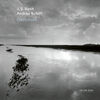100% Baroque
Antonio Vivaldi, Johann Sebastian Bach, Georg Friedrich Haendel, Marc-Antoine Charpentier, Georg Philipp Telemann, Tomaso Albinoni, Domenico Scarlatti
Classical - Released November 12, 2018 | Armasi
J.S. Bach: Goldberg Variations
Víkingur Ólafsson
Classical - Released October 6, 2023 | Deutsche Grammophon (DG)
Bach: Violin Sonatas Nos. 1 & 2 - Partita No. 1
Hilary Hahn
Violin Solos - Released October 5, 2018 | Decca Music Group Ltd.
Rachmaninov : Piano Concertos 2, 4 - Bach-Rachmaninov : Partita BWV 1006
Daniil Trifonov
Classical - Released October 12, 2018 | Deutsche Grammophon (DG)
Bach: Goldberg Variations Reimagined
Rachel Podger
Classical - Released October 20, 2023 | Channel Classics
Bach Generations
Albrecht Mayer
Classical - Released August 4, 2023 | Deutsche Grammophon (DG)
Bach: Goldberg Variations
Lang Lang
Classical - Released September 4, 2020 | Deutsche Grammophon (DG)
Vivaldi 12 Concertos Op.3 'Estro Armonico', Bach Keyboards Arrangements
Rinaldo Alessandrini
Classical - Released March 25, 2022 | naïve
J.S. Bach: The Well-Tempered Clavier, Book 2, BWV 870-893
Trevor Pinnock
Classical - Released April 8, 2022 | Deutsche Grammophon (DG)
C.P.E. Bach: Sonatas & Rondos
Marc-André Hamelin
Classical - Released January 7, 2022 | Hyperion
Bach: 6 Partitas, BWV 825-830 (2018 Recording)
Angela Hewitt
Classical - Released November 29, 2019 | Hyperion
Bach: Partitas | Sonatas BWV 1001 — 1006
Johann Sebastian Bach
Classical - Released July 28, 2023 | Delphian Records
J.S. Bach: Clavichord
András Schiff
Solo Piano - Released January 27, 2023 | ECM New Series
Johann Sebastian Bach: The Complete Works for Keyboard, Vol. 8: Köthen, 1717-1723 - For Maria Barbara
Benjamin Alard
Classical - Released May 12, 2023 | harmonia mundi
Bach: Goldberg Variations, BWV 988
Angela Hewitt
Classical - Released September 30, 2016 | Hyperion
Schubert: Die schöne Müllerin
Samuel Hasselhorn
Art Songs, Mélodies & Lieder - Released September 22, 2023 | harmonia mundi
Bach: Six Concertos for the Margrave of Brandenburg
Johann Sebastian Bach
Classical - Released December 18, 2007 | Avie Records
J.S. Bach: The Cello Suites
David Watkin
Classical - Released March 2, 2015 | Resonus Classics
Bach : Goldberg Variations, BWV 988
Lars Vogt
Classical - Released July 31, 2015 | Ondine
J. S. Bach: Goldberg Variations, BWV 988
Oliver Schnyder
Classical - Released June 16, 2023 | Prospero Classical






















 Suppose you have a more precise idea of what you want. If you are searching for the album "Bad" by Michael Jackson, type michael jackson bad. The album in question will be displayed at the top, as it is the most relevant.
Suppose you have a more precise idea of what you want. If you are searching for the album "Bad" by Michael Jackson, type michael jackson bad. The album in question will be displayed at the top, as it is the most relevant.
 By default, search results are sorted in order of relevance. The drop-down menu to the right of "Sort by" allows you to display the results in the desired order.
By default, search results are sorted in order of relevance. The drop-down menu to the right of "Sort by" allows you to display the results in the desired order.